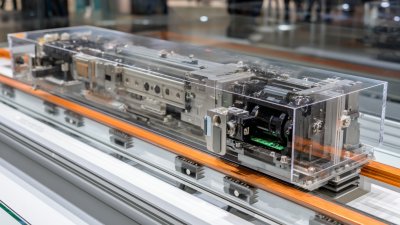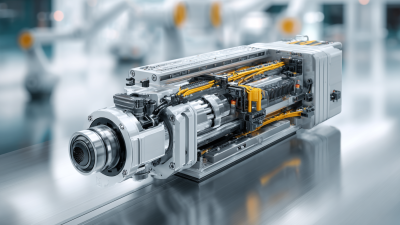Call Today: 916-259-1868

The underlying principle of voice coil motors, which operate based on electromagnetic induction, allows for high efficiency and precision in linear movement. In optical drive systems and hard disk drives, VCMs are critical components responsible for the precise positioning of read-write heads. As the need for rapid data access and retrieval increases, the reliability and performance of VCMs become ever more crucial. Furthermore, innovations in materials and design are paving the way for enhanced performance capabilities, making voice coil motors a key player in the evolution of modern technology.
In essence, understanding the science behind voice coil motors is not just an academic exercise; it is essential for leveraging their potential in cutting-edge applications, thus contributing to the advancement of various technological fields.
Voice coil motors (VCMs) have become a crucial component in various modern technologies, thanks to their ability to deliver precise motion control. Operating on the principle of electromagnetic induction, these motors consist of a coil situated within a magnetic field. When an electric current flows through the coil, it generates a magnetic force that allows for rapid adjustments in position and speed. This mechanism offers significant advantages over traditional motors, including reduced power consumption and enhanced responsiveness. According to a report by MarketsandMarkets, the global voice coil motor market is expected to reach $1.3 billion by 2025, driven by the increasing demand for automation in industries such as robotics and consumer electronics.
In the realm of consumer devices, VCMs play a pivotal role in enabling high-performance features. For instance, in smartphones and cameras, voice coil motors facilitate image stabilization and autofocus mechanisms, ensuring clear images in a variety of conditions. Research by Technavio highlights that the adoption of VCMs in optical devices is projected to grow at a CAGR of over 7% through 2024. This growth underscores the importance of VCM technology in enhancing user experience by providing smooth and efficient functionalities. As industries continue to innovate, the fundamental workings of voice coil motors will be instrumental in advancing both existing and new technologies.
Voice coil motors (VCMs) have transformed the landscape of modern technology by enabling precise motion control in a variety of applications. These motors operate on the principles of electromagnetism, allowing for rapid, accurate movement which is essential in devices ranging from smartphones to high-end medical equipment. In smartphones, VCMs drive the autofocus in cameras, ensuring crisp images by adjusting the lens position quickly and with high precision. This feature, once limited to professional photography equipment, has now become standard in consumer devices, enhancing the overall user experience.
Beyond consumer electronics, VCMs are also pivotal in advanced applications such as robotics and industrial automation. In robotic systems, VCMs provide the necessary precision for tasks like welding, packaging, and material handling. Their ability to deliver quick response times and high reliability makes them ideal for environments that require consistent performance. Furthermore, in the field of medical technology, VCMs are utilized in devices such as MRI machines and surgical tools, where accurate positioning is critical. Thus, the versatility and efficiency of voice coil motors are reshaping how modern devices function, proving their significance across various industries.
| Application Area | Device Type | Key Features | Benefits |
|---|---|---|---|
| Medical Devices | Surgical Robots | High precision, fast response | Increases patient safety and surgical accuracy |
| Consumer Electronics | Smartphones | Compact design, low power consumption | Enhanced user experience with haptics |
| Industrial Automation | Robotic Arms | High torque, speed control | Improves productivity and precision in manufacturing |
| Automotive | Active Suspension Systems | Real-time adjustments, lightweight | Enhanced ride comfort and driving safety |
| Aerospace | Flight Control Systems | Lightweight, high reliability | Improved aircraft performance and safety |
Voice coil motors (VCMs) have gained traction in a variety of applications due to their unique operational principles and advantages over traditional actuators. Unlike conventional actuators, which often rely on linear or rotary mechanical systems, VCMs utilize electromagnetic forces generated by coils and permanent magnets. This allows for highly responsive and precise movements, making them ideal for applications in automotive systems, camera autofocus mechanisms, and medical devices. The capability of VCMs to deliver rapid acceleration and change directions quickly contributes to their efficiency in high-speed applications.
However, while VCMs present significant benefits, they also come with certain disadvantages when compared to traditional actuators. For instance, VCMs generally offer a lower force output, which may limit their use in applications requiring high torque or heavy loads. Additionally, they can be more sensitive to temperature variations, which may affect performance. Traditional actuators, such as stepper motors and servos, might excel in providing greater force and are often simpler to integrate into existing systems. Thus, while VCMs are revolutionizing specific sectors with their precision and speed, the choice between VCMs and traditional actuators ultimately depends on the application's specific requirements.
Voice coil motors (VCMs) represent a significant advancement in the realm of electromechanical systems, providing precise control of motion with minimal inertia and rapid response times. To enhance the performance of VCMs, innovative design strategies are crucial. One such strategy involves optimizing the geometry of the coil and magnet arrangement to maximize the magnetic field interaction. By utilizing computer-aided design simulations, engineers can tailor the shape and positioning of these components to achieve higher efficiency and output power. This optimization not only boosts the performance of VCMs but also contributes to their compactness, making them suitable for applications where space is at a premium.
Another promising design approach focuses on the development of advanced materials that improve thermal management and durability. By incorporating materials with high thermal conductivity and low weight, engineers can mitigate the heat generated during prolonged use, ensuring consistent performance under demanding conditions. Additionally, the integration of smart sensors within the VCMs can facilitate real-time monitoring and adaptive control strategies, allowing for fine-tuned operational adjustments. This synergy of innovative materials and intelligent control systems enhances the overall performance of voice coil motors, positioning them as indispensable components in various modern technologies, from robotics to high-fidelity audio systems.
Voice coil motors (VCMs) are at the forefront of technological evolution, offering transformative possibilities across various industries. As devices become smaller and more complex, the demand for precise and efficient movement has skyrocketed. Future trends indicate an increased integration of VCMs in fields such as robotics, consumer electronics, and medical devices. The ability of VCMs to deliver rapid, accurate positioning makes them ideal for applications ranging from autofocus systems in cameras to advanced surgical equipment that requires exact movements.
Moreover, the continuous advancements in materials science and engineering processes are set to further enhance VCM performance. Developments such as improved magnetic materials and innovative cooling mechanisms promise greater efficiency and responsiveness. Additionally, the rise of smart technologies and the Internet of Things (IoT) presents new opportunities for VCM applications. As devices become interconnected, VCMs will play a crucial role in creating responsive systems capable of adapting to user preferences and environmental changes. The future landscape of technological innovations will undoubtedly be shaped by the versatility and precision inherent in voice coil motors.






Sierramotion engineers help customers design solutions to complex motion problems. Whether a simple coil, or a precision motion assembly working in vacuum, Sierramotion has the experience to create a solution that works the first time.